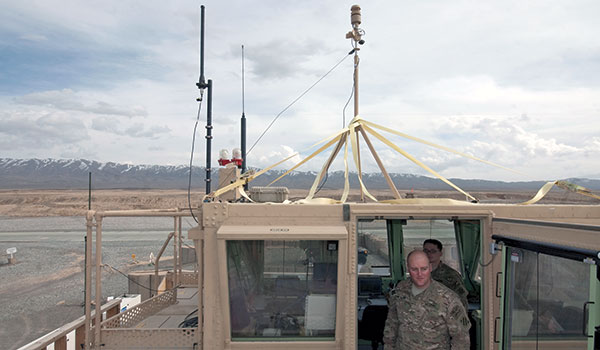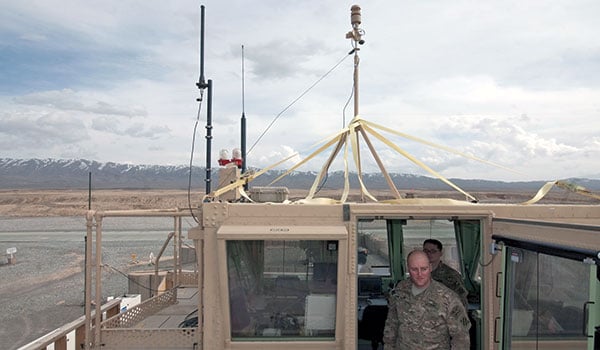
Chief Warrant Officer of the Branch / By CW5 Allen R. Godfrey: As the Army and therefore Army Aviation transitions to greater expeditionary operations, our aircraft and crews will operate in austere environments and locations. These environments and locations may not have established air traffic and airspace facilities and procedures.

Soldiers from Foxtrot Company, 2nd Battalion, 3rd Aviation Regiment, Task Force Viper, control air traffic from the AN/MSQ-135 Mobile Tower System, or MOTS, Feb. 20 at Forward Operating Base Wolverine, Afghanistan./U.S. ARMY PHOTO BY SGT LUKE ROLLINS
Additionally, there may be numerous aircraft, platforms, weapons, and other objects occupying and operating in the airspace. In order to operate safely and efficiently in the complex battlespace on and above the ground, we need specialized expert combat leaders, agile and adaptive to meet the demands in the complex world. These experts are Air Traffic and Air Space Management (ATASM) Warrant Officers.
DA Pam 600-3 outlines the definition and career model of the ATASM warrant officer. Military Occupational Specialty (MOS) Air Traffic and Airspace Management technicians supervise the effective utilization of Air Traffic Service (ATS) equipment and ATS personnel at all categories of Army ATS facilities. They supervise fixed base ATS training and rating programs, combat support training and certification programs, and combat support and fixed base facility operations procedures; and supervises airspace management functions and airspace processing procedures into the National Airspace System. Additionally, they will develop procedures in areas of operation in conjunction with other military services or host nations as applicable.
Selection and Training
The selection process for this warrant officer specialty is highly competitive. Potential candidates are already proven leaders from the 15Q Air Traffic Control Operator MOS. These applicants must be a sergeant or above. They must have a minimum 5 years’ experience in the MOS and hold an Air Traffic Control Tower rating or Radar Air Traffic Control rating. They must also have two years’ experience in air traffic control leadership positions such as tactical team leader or shift leader. Selection to attend Warrant Officer Candidate School and the ATASM Warrant Officer Basic Course (WOBC) is a proud moment in a Soldier’s career. Those selected show they are ready to uphold the trust and confidence placed in them to be the next leaders.
The WOBC trains ATASM Warrant Officers in the subject areas including Employment of Tactical Air Traffic Services Equipment; Air Traffic Services Facility Operations, Training, and Maintenance; Supervision of Facility Rating Programs; Terminal Instrument Procedure Development; Quality Assurance and Standardization; Airspace Doctrine and Procedures; Airspace Staff Activities; Air Traffic Control and Airspace Technical Assistance; and Airfield Management Responsibilities and Functions.
After completion of WOBC, the initial assignment is as a platoon leader in tactical ATS companies and airfield operations battalions. This is an opportunity to develop the skills as a leader and expert in combat aviation operations. After this initial assignment, they are ready to attend the Aviation Warrant Officer Advanced Course (AWOAC).
Advanced Training
During AWOAC, senior CW2s and CW3s are focused on warfighting and training. Army Aviation’s primary operators understand how to win in a complex world and are trained and educated to effectively apply doctrine, understand the operational environment and threats, manage training, manage operational risk, maintain and sustain combat power, employ weapons, apply tactics and lead in combat. ATASM warrant officers receive specific training to enhance and expand areas learned in WOBC and in the unit. The course has a common scenario to drive all training and focus discussion in a decisive action training environment. This course culminates with the Chief Warrant Officer Exercise where all the warrant officer aviators and technicians apply their respective skills in an offensive focus against a simulated near peer adversary.
Promotion potential remains high for ATASM warrant officers. This program restarted in 2008 after two decades. Our previous senior ATASM warrant officers have since retired. This allows enhanced advancement opportunities for leaders showing demonstrated potential for increased responsibilities. For those continually performing at higher levels of responsibility, they can continue for 30 years as a warrant officer.
Look for the article later in the issue from CW3 Pinckney, ATASM Course Chief, and DAC Sweeney, ATASM Course Manager, which highlights some issues and questions about the future. This MOS is expanding in the roles, responsibilities, and scope. As the Army and Army Aviation force structure changes, the vital Army Aviation mission will remain. Our expert warrant officers will be ready to accept these expanding roles and responsibilities.
Remember to start our day asking, “What are we doing for the Warfighter?”
At the end of the day, the answer is, “We provided no fail support to the Warfighter on the ground and in the air.”
“Above the Best”
CW5 Allen R. “Randy” Godfrey is the chief warrant o.cer of the Aviation Branch with the U.S. Army Aviation Center of Excellence, Fort Rucker, AL.










